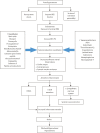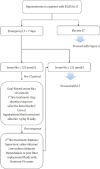Evidence-based hyponatremia management in liver disease
- PMID: 37280091
- PMCID: PMC10577348
- DOI: 10.3350/cmh.2023.0090
Evidence-based hyponatremia management in liver disease
Abstract
Hyponatremia is primarily a water balance disorder associated with high morbidity and mortality. The pathophysiological mechanisms behind hyponatremia are multifactorial, and diagnosing and treating this disorder remains challenging. In this review, the classification, pathogenesis, and step-by-step management approaches for hyponatremia in patients with liver disease are described based on recent evidence. We summarize the five sequential steps of the traditional diagnostic approach: 1) confirm true hypotonic hyponatremia, 2) assess the severity of hyponatremia symptoms, 3) measure urine osmolality, 4) classify hyponatremia based on the urine sodium concentration and extracellular fluid status, and 5) rule out any coexisting endocrine disorder and renal failure. Distinct treatment strategies for hyponatremia in liver disease should be applied according to the symptoms, duration, and etiology of disease. Symptomatic hyponatremia requires immediate correction with 3% saline. Asymptomatic chronic hyponatremia in liver disease is prevalent and treatment plans should be individualized based on diagnosis. Treatment options for correcting hyponatremia in advanced liver disease may include water restriction; hypokalemia correction; and administration of vasopressin antagonists, albumin, and 3% saline. Safety concerns for patients with liver disease include a higher risk of osmotic demyelination syndrome.
Keywords: Hyponatremia; Liver cirrhosis; Liver disease; Water-electrolyte imbalance.
Conflict of interest statement
The authors have no conflicts to disclose.
Figures






Comment in
-
Letter regarding "Evidence-based hyponatremia management in liver disease".Clin Mol Hepatol. 2023 Oct;29(4):1043-1045. doi: 10.3350/cmh.2023.0204. Epub 2023 Jul 5. Clin Mol Hepatol. 2023. PMID: 37403318 Free PMC article. No abstract available.
-
Correspondence on Letter regarding "Evidence-based hyponatremia management in liver disease".Clin Mol Hepatol. 2023 Oct;29(4):1048-1049. doi: 10.3350/cmh.2023.0261. Epub 2023 Aug 14. Clin Mol Hepatol. 2023. PMID: 37583054 Free PMC article. No abstract available.
References
-
- Spasovski G, Vanholder R, Allolio B, Annane D, Ball S, Bichet D, et al. Hyponatraemia Guideline Development Group Clinical practice guideline on diagnosis and treatment of hyponatraemia. Eur J Endocrinol 2014;170:G1-G47. Eur J Endocrinol. 2014;170:G1–G47. Erratum in: Eur J Endocrinol 2014;171:X1. - PubMed
-
- Ginés P, Berl T, Bernardi M, Bichet DG, Hamon G, Jiménez W, et al. Hyponatremia in cirrhosis: from pathogenesis to treatment. Hepatology. 1998;28:851–864. - PubMed
-
- Angeli P, Wong F, Watson H, Ginès P, CAPPS Investigators Hyponatremia in cirrhosis: results of a patient population survey. Hepatology. 2006;44:1535–1542. - PubMed
-
- Guevara M, Baccaro ME, Torre A, Gómez-Ansón B, Ríos J, Torres F, et al. Hyponatremia is a risk factor of hepatic encephalopathy in patients with cirrhosis: a prospective study with timedependent analysis. Am J Gastroenterol. 2009;104:1382–1389. - PubMed
-
- Heuman DM, Abou-Assi SG, Habib A, Williams LM, Stravitz RT, Sanyal AJ, et al. Persistent ascites and low serum sodium identify patients with cirrhosis and low MELD scores who are at high risk for early death. Hepatology. 2004;40:802–810. - PubMed
Publication types
MeSH terms
Substances
Grants and funding
LinkOut - more resources
Full Text Sources
Medical

